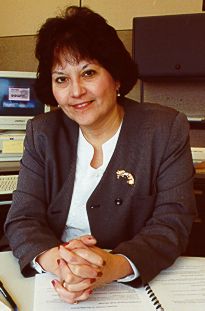 |
 |







|
 |
 |
 |
 |
 |
 |
 |
 |
 |
 |
|
 |
|
|
 |
 |
 |
Mn/DOT prepares for spring flooding
|
 |
 |
 |
The disastrous floods of 1997 caused
extensive damage to the stateís highways. The floods affected several
regions of the state, including the northwest where floodwaters from the
Red River of the North and the Snake, Tamarac and Middle rivers covered
vast stretches of land and washed out several sections of highway. On
Highway 1 near Oslo in Marshall County, Dave Dalager, Bemidji District
maintenance superintendent (center); Cliff Schulz, a transportation generalist
at Crookston (left); and Richard Kjensrud, now retired maintenance supervisor
at Thief River Falls (right) examine damage to the roadbed.
|
If (or when) the floodwaters
rise this spring, Mn/DOT will be prepared to handle any possible impacts to
the stateís transportation system, according to Bob Vasek, maintenance operations
support engineer.
Staff from the Office of Maintenance and the Office of Communications
and Public Relations have been meeting to lay out plans for any emergencies
that may arise. Strategies include:
- Developing procedures to ensure that road condition
reports are entered into MnCARS (Condition and Acquisition Reporting System)
on a timely basis
- Using MnCARS reports to update the departmentís
road condition information telephone system and the TripUSA road condition
website
- Reviewing procedural guidance for updates prior
to distributing to district offices
- Updating Mn/DOT and contractor contact lists
- Alerting news media around the state as conditions
change and roads close or open
The state duty officer at the Department of Public Safetyís
Division of Emergency Management is available around-the-clock to coordinate
assistance. If flooding is severe, DEM will activate the Statewide Emergency
Operations Center. Once activated, the center is open 24 hours-a-day and staffed
with employees from many different state agencies. The center was activated
in the spring of 1997 when wide-spread flooding wreaked havoc on many communities
across the state. It was last used to deal with potential Y2K-related emergencies
over New Yearís weekend 1999.
In addition to giving accurate and timely information to
the public, Mn/DOT provides many other resources to assist in natural disasters.
Under Vasekís direction, Mn/DOTís Office of Maintenance coordinates inter-district
and interagency transfer of equipment and resources to hard-hit areas.
The Office of Maintenance, in coordination with the Office
of Investment Management, State Aid, DEM and the Federal Highway Administration,
also provides assistance to district offices on federal disaster assistance
programs. Road closures, sandbagging roadways and debris cleanup are among the
activities necessary in flooded areas. Coordination meetings and disaster drills
are held on a regular basis to keep state agencies up-to-speed with disaster
planning and emergency preparedness. District maintenance staff also repair
most of the damage done to the Interstate and trunk highway systems caused by
floods. Sites suffering greater damage may use contractors for repairs and cleanup,
he said.
For more information, contact Bob Vasek at 651/297-5113.
You can link to the National
Weather Serviceís site to see the latest flooding
forecasts.
By Kent Barnard
|
back

|
 |
State, Metropolitan Council
file counterclaim against Xcel Energy
|
 |
 |
Just weeks after breaking
ground for the Hiawatha light rail transit line in Minneapolis, state and Metropolitan
Council officials were in federal court on March 8 to ensure the project continues
on track.
Mn/DOT, the State of Minnesota and the Metropolitan Council
want the court to enforce Commissioner Elwyn Tinklenbergís order that Xcel Energy
relocateóat its own expenseóthe electric utility lines that lie beneath 5th
Street in downtown Minneapolis along the planned LRT route.
The governmentís action came after Xcel filed a lawsuit
Feb. 16 requesting reimbursement for the cost of relocating the utility lines,
estimated to be about $18 million.
Historically, utility companies have been allowed to use
public rights-of-way at no charge, with the understanding that if the land were
needed for a public project, the utility companies relocate at their expense.
The stateís counterclaim also asks that Xcel be required
to post a $330 million bondóthe equivalent amount of federal funds that could
be lost because of Xcelís actions.
Groundbreaking ceremonies for the Hiawatha LRT line were
held Jan. 17. The 11.6-mile route will stretch from downtown Minneapolis to
the Mall of America in Bloomington. The project is scheduled for completion
in 2004.
For more information, see the March
8 LRT news release, view the LRT
page on Mn/DOTís Web site, or contact Mary McFarland, Communications and Public
Relations, 651/284-4035.
|
back

|
 |
Commissionerís forum focuses on Mn/DOTís customers
|
 |
 |
What used to be called the "the travelling public" has been refined
into eight customer segments, Karla Rains, Market Research Unit, told the 170
Mn/DOT managers who attended the Commissionerís Forum on March 7.
The theme of the forum was customersówho they are and what they wantóand Rainsí
presentation was packed with information on the topic. The eight customer segments
are commuters, personal travelers, farmers, emergency vehicle operators, carriers/haulers,
shippers (truck only), intermodal shippers, and communities/ neighborhoods/
adjacent land owners, she said.
Some facts about Mn/DOTís customers include:
- Commuters and personal travelers are the two largest segments.
- Farmers are probably the most unique customer segment.
- Communities/neighborhoods/adjacent landowners are the most
diverse and the most fluid. This segment includes individuals brought together
for a common purpose or issue. The size of this segment depends upon the topic
and the size of the group assembled.
Customer research database information will soon be available to employees
on a "real time" basis. Training will be offered to interested employees
so that they can see how customers have rated Mn/DOT products and services and
use that information for making business decisions.
For more information, contact Karla Rains, 651/284-3886, or Marie Blomquist,
651/455-4610.
Changing workforce demographics
Other topics at the forum highlighted the changing workforce. Half of those
employees eligible to retire by 2006 will be professionals, managers and administrators.
Mark Carlson, director, Office of Human Resources, indicated that there arenít
enough employees available to staff state government at its present level. Mn/DOT
is one of the agencies predicted to suffer the most.
How can we meet our customer needs with a shrinking workforce? According to
Carlson, measures like building leadership capacity, investing in training and
development, and rethinking some of our processes are a few of the strategies
that will address meeting customer needs in the future.
The human resource staff is available upon request to deliver demographic briefings
tailored to your office or district. Contact Mark Carlson, 651/284-4025 for
more information.
Increased workforce diversity
Not only is the workforce shrinking, itís looking different, too, as the session
on diversity demonstrated. Given by Mike Garza and Keith Baker, Office of EEO
Contract Management, the session talked about how todayís workforce is a mosaic
of skills, lifestyles, religions, ethnic groups, genders and ages. If Mn/DOT
is to succeed as an organization, it needs to create positive environments where
all people can reach their full potential. Morale and productivity improve when
all member of a work group are valued and respected. The session was introduced
with a video showing how poor communication between diverse individuals can
exacerbate productivity, create poor working relationships and hamper organizational
effectiveness.
Mike Garza, 651/296-6899, and Keith Baker, 651/297-1869, are available to meet
with work groups to discuss diversity and its implications for individual work
areas.
Forum follow-up
Materials from the Commissionerís Forum are available to
employees. Videotapes of the commissionerís remarks will be available for viewing
at staff meetings. Contact Mn/DOTís
library for a copy. Watch Mn/DOT Newsline for
an announcement when the questions (and answers) from the forum are posted.
Management Leadership Team
On March 6, the Management Leadership Team met to hear updates on information
resource management, geographic information systems and the service agreement
pilot overview. Afternoon sessions highlighted the program delivery streamlining
team, the Bill Yoerg quality awards survey and a discussion of activity based
costing/management.
Managers convene quarterly for the Commissionerís Forums and Management Leadership
Team meetings to work on strategic and operational issues.
By Sue Stein4035.
|
back

|
 |
Transportation
committee members rate Mn/DOTís performance |
 |
 |
Transportation committee members overall are satisfied with
Mn/DOT and generally perceive the information they receive from the department
to be reliable, according to a recent legislative survey conducted by Mn/DOTís
marketing research unit.
Chris McMahon, senior research analyst, reported the results
of the survey at the Commissionerís Forum on March 7. In January, Mn/DOT market
researchers met individually with transportation committee members in the Minnesota
House of Representatives and Senate, asking them what they thought Mn/DOT was
doing well at and how it could improve.
Mn/DOT could be less bureaucratic and communicate better
with legislatorsósuch as providing more understandable information that doesnít
conflict with previous information sent from the department, according to the
findings. Committee members also would like to see information provided more
proactively (e.g., notify them earlier when changes occur, provide them with
more "unfiltered" information), McMahon said.
Committee members also recommended that Mn/DOT seek more
public involvement in projects earlier in the planning process, and anticipate
and communicate earlier any potential negative impacts of projects on communities.
Despite pointing out several areas in which Mn/DOT could
improve, 71 percent of the legislators surveyed believe the department is performing
"very or somewhat well" as an agency, McMahon said.
Based on the results of the survey, Mn/DOT is now drafting
action steps to address the areas it needs to improve upon.
For more information about the legislative survey, contact
Chris McMahon, 651/284-3243.
To learn more about transportation-related legislation,
click on Mn/DOTís weekly
legislative summary or check out its Government
Relations Web site. For more information about
legislative issues, contact Joe Hudak, legislative assistant, at 651/297-5149.
|
back

|
 |
Mn/DOT, partners offer training for construction truck operators
|
 |
 |
A fatal crash in 1997 involving a dump truck traveling from
a Mn/DOT construction site prompted the department to look for ways to reduce
crashes involving construction vehicles in Mn/DOT construction work zones.
In the succeeding years, Mn/DOT and its partners in the
construction and safety industries have instituted a number of programs with
the goal of improving safety through targeted enforcement, safety training seminars
and safety awareness campaigns, said Ted Coulianos, communications and training
supervisor, Office of Motor Carrier Services.
These measures include:
- Targeted vehicle safety inspections around many
Mn/DOT project sites by State Patrol commercial vehicle inspection teams
- Training classes on construction industry safety
regulations given by the Office of Motor Carrier Services
- A new training curriculum jointly developed
in 1999 by Mn/DOT, the Minnesota Highway Safety Center, the State Patrol,
the Minnesota Asphalt Pavers Association and the Minnesota Trucking Association.
(Seventeen classes have been held with 500 truck operators attending.)
This year will see a 40 percent increase in program participation,
with five levels of training available, Coulianos said. Classes are held from
late November through March during the off-season for the construction industry.
Training topics include an overview of regulations, hands-on vehicle inspection
procedures, behind-the-wheel vehicle dynamics, techniques for securing loads
and proper transportation of hazardous materials.
"Our goal is to have every operator of a construction
vehicle operating on Minnesota roadways go through a CTOT instruction and receive
certification," Coulianos said.
Proof of certification is carried in the vehicle and is
presented to the State Patrol during roadside inspections at the construction
work zones. Unless the State Patrol sees an obvious violation, a CTOT-certified
operator likely will be waved through inspection. CTOT offers enhanced safety
for motorists on the roadways, lower insurance rates for trucking operators,
driver recognition and advancement possibilities and a coordinated training
partnership between state agencies.
"The partnership of industry and industry regulators
makes this an exceptional training opportunity. It has been well received by
our drivers," reports Rick Maursetter, safety director for Duininck Brothers
Construction.
For more information on the CTOT training program, contact
the Office of Motor Carrier Services at 651/405-6060. For more information about
Mn/DOTís work zone safety program, contact Mary Meinert, 651/297-5868.
By Mary Meinert
|
back

|
 |
Willmar, Detroit Lakes districts earn safety awards
|
 |
 |
For recording no lost-time injuries and no employee days lost to injuries during
2000, the Willmar District earned a safety award from the Senior Management
Team/Department-wide Safety Committee.
The Detroit Lakes District also earned honors for having low workersí compensation
rates and lost time injuries during the past six years and for its commitment
to safety and wellness education programs during the past decade.
The Willmar District was cited for avoiding a possible 556 lost employee days
by having policy in place to provide light-duty jobs available immediately for
12 employees injured during 2000.
Dave Solsrud, Willmar assistant district engineer, said the districtís accomplishment
was also supported by its policy of requiring a doctorís visit for head, neck
and back injuries and an agreement with physicians to issue a report on a injured
employeeís "workability" to help managers find an appropriate alternate
work assignment for them.
Detroit Lakes was cited for outstanding teamwork and communication by employees,
supervisors and managers to develop its safety and wellness program during the
past 10 years.
The awards were presented March 13 in St. Paul by Doug Weiszhaar, deputy commissioner,
and Jim Swanson, assistant commissioner, Program Delivery Group.
Mark Pierskalla, Willmar safety administrator, accepted the award for the district.
Bill Hanson, safety administrator at Detroit Lakes, accepted the award for his
district.
In presenting the awards, Weiszhaar said, "Safety is not just any one
personís responsibility; itís everybody working together. These awards are tremendous
examples of what we need to instill across the state."
By Craig Wilkins
|
back

|
 |
Wagner named director of Contract Management
|
 |
 |
 |
|
Joanne Wagner
|
Joanne Wagner, an attorney
with 15 yearsí service in the private sector, was appointed as director of the
Office of Contract Management. She succeeds Mary Helbach who resigned.
Wagner holds a law degree from the William Mitchell College
of Law in St. Paul and a bachelorís degree in political science from the University
of Minnesota. A St. Paul native, Wagner lives in Roseville.
Wagnerís office is in Room 361 of the Transportation Building.
She may be reached at 651/215-0446, MS 130.
Photo by Craig Wilkins
|
back

|
 |
Schadauer to lead Northstar Corridor commuter rail project
|
 |
 |
Mike Schadauer recently was appointed as project manager for the Northstar
Corridor commuter rail project with the Office of Passenger Rail Transit.
Currently the director of planning and environment on the Hiawatha light rail
transit project in Minneapolis, Schadauer will begin immediately making the
transition to his new position and will be fully dedicated to the Northstar
Corridor commuter rail project by May.
Schadauer is a registered professional engineer and has been employed by Mn/DOT
since 1983.
The Northstar Commuter rail will run between St. Cloud and Minneapolis.
|
back

|
 |
Reading buddies take a break from the books
|
 |
 |
 |
Jim Harris, IRM, a participant in the Reading Buddies
program, checks out a Mn/DOT snowplow near the Capitol with his reading
buddy, Mike Hang.
|
Students from Franklin Elementary
School in St. Paul and their adult reading partners from eight state agencies
varied their routine one day to eat pizza, visit the Capitol and explore a Mn/DOT
snowplow.
The students and adults are part of the Reading Buddies
program, which matches a state employee with a student for weekly sessions.
The mentors read aloud to children in the first through fourth grades.
Program coordinator Janet Berryhill of the Minnesota Office
of Environmental Assistance notes there are 250 employees enrolled in the program
designed to improve the studentsí reading and listening skills. This is the
programís fourth year, she said. Reading Buddies will expand to include fifth
graders next year, she adds.
Jim Harris, Information Resource Management, one of the
Mn/DOT employees in the program, said itís rewarding to work with the students
and participate in the progress they make in language skill development, especially
those for whom English is a second language.
Harrisí buddy is Mike Hang, a fourth-grader at Franklin.
"We get nice feedback from the kids, including handmade
Valentines," Harris said. "Every time I go there Mikeís face lights
up when he gets out of class. Itís a nice relationship. I hope Iím helping my
buddy learn more English."
Story and photo by Craig Wilkins
|
back

|
 |
Question of the Week: How to open a bottleneck
|
 |
 |
How has the workload for Mn/DOT employees "in the trenches"
been affected by the Moving Minnesota funds the department received in 2000
to provide advantages for transit, open bottlenecks and improve interregional
corridors? One Mn/DOT employee indirectly provides one piece of the answer by
asking this weekís Question
of the Week.
|
back

|
|
 |
| |


